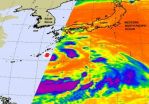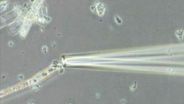(Press-News.org) Tropical Storm Roke has changed in size and is starting to change in strength. Roke appears to be consolidating in infrared imagery from NASA's Aqua satellite.
Roke began its life as a monsoon depression with a large low-level circulation center that over time consolidated and organized. The eastern half of Tropical Storm Roke was seen in an infrared image from NASA's Aqua satellite AIRS (Atmospheric Infrared Sounder) on Sept. 15, and it showed a more consolidated center with strong convection and very cold cloud-top temperatures.
Cloud-top temperatures are important because they tell forecasters how high thunderstorms are, and the higher the thunderstorm, the colder the cloud tops and the more powerful the thunderstorms. Cloud top temperatures near Roke's center were near -63 F/-52 C, indicating strong convection.
Infrared imagery also helped forecasters indentify that the center of the storm had recently turned to the southwest.
On Friday, Sept. 16, Tropical Storm Roke had maximum sustained winds near 46 mph (40 knots/74 kmh) and was located approximately 105 nautical miles (120 miles/194 km) east of Kadena Air Base, Japan, near 26.0 North and 129.5 East. Roke was moving slowly to the south-southwest at 2 knots (3 mph). Roke is over 200 miles (321 km) in diameter with tropical-storm-force winds extending out 100 miles (160 km) from the center.
Roke is in a good environment to develop because wind shear (winds that can tear a tropical cyclone apart) remain light and under 5 knots. AIRS infrared data revealed that sea surface temperatures are over the 80F (26.6C) threshold to maintain a tropical cyclone and are in fact as warm as 82F (28C), which will allow Roke to strengthen.
Because there's not much of a steering mechanism to guide Roke , the storm has zig-zagged through the western North Pacific Ocean this week. The Joint Typhoon Warning center noted that there is still no strong steering mechanism, and expects Roke to slowly approach Kadena Air Base over the weekend.
INFORMATION:
Infrared satellite data shows Tropical Storm Roke strengthening
2011-09-19
ELSE PRESS RELEASES FROM THIS DATE:
Study suggests possible link between two Type 2 diabetes drugs and pancreatic cancer
2011-09-19
Two newer drugs used to treat Type 2 diabetes could be linked to a significantly increased risk of developing pancreatitis and pancreatic cancer, and one could also be linked to an increased risk of thyroid cancer, according to a new UCLA study.
Researchers from the Larry L. Hillblom Islet Research Center at UCLA examined the U.S. Food and Drug Administration's database for adverse events reported between 2004 and 2009 among patients using the drugs sitagliptin and exenatide. They found a six-fold increase in the odds ratio for reported cases of pancreatitis with these ...
People born after World War II are more likely to binge drink and develop alcohol disorders
2011-09-19
September 15, 2011 --. In a review of 31 peer-reviewed and published studies, researchers at Columbia University's Mailman School of Public Health looked generational and gender differences in alcohol consumption, alcohol disorders, and mortality. Findings indicate that people born after World War II are more likely to binge drink and develop alcohol use disorders. Researchers also found that the gender gap in alcoholism and problem drinking is narrowing in many countries.
Findings will be published in the December 2011 issue of Alcoholism: Clinical & Experimental Research ...
Autism, intellectual disabilities related to parental age, education and ethnicity, not income
2011-09-19
SALT LAKE CITY – New research from the University of Utah in collaboration with the Utah Department of Health (UDOH) shows that the presence or absence of intellectual disability (ID) and autism spectrum disorders (ASD) varies with risk factors such as gender, parental age, maternal ethnicity, and maternal level of education. The study, published Sept. 15, 2011, in Autism Research, also shows that household income level has no association with either ID or ASD, in contrast to what other studies have suggested.
ASDs are a group of childhood neurodevelopmental disorders ...
Good news for rural stroke patients: Virtual stroke care appears cost-effective
2011-09-19
ST. PAUL, Minn. – In a first of its kind study, researchers have found that using two way audio-video telemedicine to deliver stroke care, also known as telestroke, appears to be cost-effective for rural hospitals that don't have an around-the-clock neurologist, or stroke expert, on staff. The research is published in the September 14, 2011, online issue of Neurology®, the medical journal of the American Academy of Neurology.
"In an era of spiraling health care costs, our findings give critical information to medical policy makers," said Jennifer J. Majersik, MD, MS, ...
Low-fat yogurt intake when pregnant may lead to child asthma and hay fever
2011-09-19
Amsterdam, The Netherlands: Eating low-fat yoghurt whilst pregnant can increase the risk of your child developing asthma and allergic rhinitis (hay fever), according to recent findings.
The study will be presented at the European Respiratory Society's (ERS) Annual Congress in Amsterdam on 25 September 2011. All the abstracts for the ERS Congress will be publicly available online from today (17 September 2011).
The study aimed to assess whether fatty acids found in dairy products could protect against the development of allergic diseases in children.
The researchers ...
Crystal structure shows how motor protein works
2011-09-19
The crystal structure of the dynamin protein — one of the molecular machines that makes cells work — has been revealed, bringing insights into a class of molecules with a wide influence on health and disease.
"It's a really cool structure," said Jodi Nunnari, professor and chair of molecular and cellular biology at UC Davis and senior author of the paper, to be published Sept. 18 in the journal Nature. "This is a really important class of molecules for regulating membrane dynamics."
The detailed structure reveals exactly how the dynamin protein can form large assemblies ...
Osteoporosis Phase III data at 2011 ASBMR Show oral calcitonin tablet is safe and effective
2011-09-19
SAN DIEGO, CA and PHILADELPHIA, PA – September 18, 2011 —Tarsa Therapeutics today presented positive safety and efficacy data from its Phase III ORACAL trial of OSTORA™, the company's oral recombinant salmon calcitonin tablet in development for the treatment of postmenopausal osteoporosis. These data were presented at the American Society for Bone and Mineral Research 2011 Annual Meeting by ORACAL investigator Neil Binkley, MD, who is an Associate Professor of Endocrinology and Geriatrics at the University of Wisconsin School of Medicine and Public Health in Madison, ...
Why carbon nanotubes spell trouble for cells
2011-09-19
VIDEO:
Receptors on the cell's surface crowd around the nanotube, effectively standing it upright. The cell mistakes the tube for a sphere and begins to engulf it.
Click here for more information.
PROVIDENCE, R.I. [Brown University] — It's been long known that asbestos spells trouble for human cells. Scientists have seen cells stabbed with spiky, long asbestos fibers, and the image is gory: Part of the fiber is protruding from the cell, like a quivering arrow that's found ...
Researchers sequence dark matter of life
2011-09-19
Researchers have developed a new method to sequence and analyze the dark matter of life—the genomes of thousands of bacteria species previously beyond scientists' reach, from microorganisms that produce antibiotics and biofuels to microbes living in the human body.
Scientists from UC San Diego, the J. Craig Venter Institute and Illumina Inc., published their findings in the Sept. 18 online issue of the journal Nature Biotechnology. The breakthrough will enable researchers to assemble virtually complete genomes from DNA extracted from a single bacterial cell. By contrast, ...
Deep oceans can mask global warming for decade-long periods
2011-09-19
BOULDER -- The planet's deep oceans at times may absorb enough heat to flatten the rate of global warming for periods of as long as a decade even in the midst of longer-term warming, according to a new analysis led by the National Center for Atmospheric Research (NCAR).
The study, based on computer simulations of global climate, points to ocean layers deeper than 1,000 feet (300 meters) as the main location of the "missing heat" during periods such as the past decade when global air temperatures showed little trend. The findings also suggest that several more intervals ...


